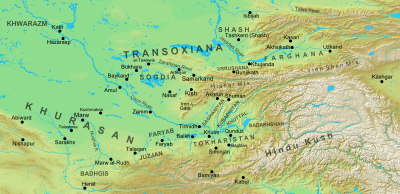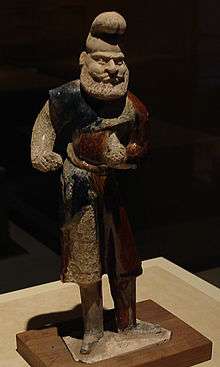Transoxiana
Transoxiana (also spelled Transoxania), known in Arabic sources as Mā Warāʾ an-Nahr (Arabic: ما وراء النهر, [ˈmaː waˈraːʔ anˈnahr] – '[what is] beyond the [Oxus] river') and in Persian as Farârud (Persian: فرارود, [fæɾɒːˈɾuːd̪]—'beyond the [Amudarya] river'), is the ancient name used for the portion of Central Asia corresponding approximately with modern-day Uzbekistan, Tajikistan, southern Kyrgyzstan, and southwest Kazakhstan. Geographically, it is the region between the Amu Darya and Syr Darya rivers.[1] The area had been known to the ancient Iranians as Turan, a term used in the Persian national epic Shahnameh,[2] and to the Romans as Transoxania (Land beyond the Oxus). The Arabic term Mā warāʼ an-Nahr (Land Beyond the River) passed into Persian literary usage and stayed on until post-Mongol times.[3]

The region was one of the satrapies (provinces) of the Achaemenid dynasty of Persia under the name Sogdiana. It was defined within the classical world of Iran to distinguish it from Iran proper, especially its northeastern province of Khorasan[4]—a term originating with the Sasanians[5]—although early Arab historians and geographers tended to subsume the region within the loosely defined term "Khorasan" designating a much larger territory.[6][7] The territories of Khwarazm, Sogdiana, Chaghaniyan, and Khuttal were located in the southern part of Transoxiana; Chach, Osrushana, and Farghana were located in the northern part.[8]
History
The name Transoxiana stuck in Western consciousness because of the exploits of Alexander the Great, who extended Greek culture into the region with his invasion in the 4th century BC. Alexander's successors would go on to found the Greco-Bactrian Kingdom, ushering in a distinct Greek cultural presence within Transoxiana that existed for over two hundred years. The city of Ai Khanoum, situated on the Oxus river in northern Afghanistan, remains the only Graeco Bactrian city to have been found and extensively excavated.[9]
During the Sassanid Empire, it was often called Sogdiana, a provincial name taken from the Achaemenid Empire, and used to distinguish it from nearby Bactria.
The Chinese explorer Zhang Qian, who visited the neighbouring countries of Bactria and Parthia along with Transoxiana in 126 BC, made the first known Chinese report on this region. Zhang Qian clearly identifies Parthia as an advanced urban civilisation that farmed grain and grapes, and made silver coins and leather goods.[10] It was ruled successively by Seleucids, the Greco-Bactrian Kingdom, the Parthian Empire and the Kushan Empire before Sassanid rule.
In Sassanid times, the region became a major cultural center due to the wealth derived from the Northern Silk Road. Sassanid rule was interrupted by the Hephthalite invasion at the end of the 5th century and didn't return to the Sassanids until 565. Many Persian nobles and landlords escaped to this region after the Muslim conquest of Persia. It was also ruled by Göktürks until the Arab conquest between 705 and 715, the area became known as Mā warāʼ al-Nahr (Arabic, 'what is beyond the river'), sometimes rendered as "Mavarannahr".
Transoxiana's major cities and cultural centers are Samarkand and Bukhara. Both are in the southern portion of Transoxiana (though still to the north of the Amu Darya itself, on the river Zeravshan), and the majority of the region was dry but fertile plains. Both cities remained centres of Persian culture and civilisation after the Islamic conquest of Iran, and played a crucial role in the revival of Persian culture with establishment of the Samanid dynasty.
Part of this region was conquered by Qutayba ibn Muslim between 706 and 715 and loosely held by the Umayyads from 715 to 738. The conquest was consolidated by Nasr ibn Sayyar between 738 and 740, and continued under the control of the Umayyads until 750, when it was replaced by the Abbasids. The Tang dynasty also controlled the eastern part of the region until about the same time, when a civil war known as the An Lushan Rebellion occurred.
Genghis Khan, founder of the Mongol Empire, invaded Transoxiana in 1219 during his conquest of Khwarezm. Before his death in 1227, he assigned the lands of Western Central Asia to his second son Chagatai, and this region became known as the Chagatai Khanate. In 1369, Timur, of the Barlas tribe, became the effective ruler and made Samarkand the capital of his future empire. Transoxiana was known to be flourishing in the mid-14th century.[11]
Religion
The historian Mark Dickens notes:[8]
Transoxiana’s principal pre-Islamic religion was Zoroastrianism, albeit in local manifestations. However, Buddhism, Christianity, Manichaeism, and Mazdakism also had many adherents, especially in urban areas. This initial religious diversity was gradually eroded after the Arab conquest.
Notable people
See also
References
- "Transoxania (historical region, Asia)". Encyclopedia Britannica. Retrieved 2017-11-10.
- Sabloff, Paula L.W. (2011). Mapping Mongolia: Situating Mongolia in the World from Geologic Time to the Present. Philadelphia: University of Pennsylvania Museum of Archaeology and Anthropology. p. 62. ISBN 978-1934536186. OCLC 794700604.
- C. Edmund Bosworth, (2002), 'CENTRAL ASIA iv. In the Islamic Period up to the Mongols' Encyclopaedia Iranica (online)
- Svat Soucek, A History of Inner Asia, Cambridge University Press, 2000, p.4
- "Khorāsān". britannica.com. Encyclopædia Britannica, Inc. Retrieved 14 November 2018.
- C. Edmund Bosworth, (2002), 'CENTRAL ASIA iv. In the Islamic Period up to the Mongols' Encyclopaedia Iranica "In early Islamic times Persians tended to identify all the lands to the northeast of Khorasan and lying beyond the Oxus with the region of Turan, which in the Šāh-nāma of Ferdowsī is regarded as the land allotted to Ferēdūn’s son Tūr...At the outset, however, those nearby parts of Central Asia with which the Arabs were familiar were often subsumed into the vast and ill-defined province of Khorasan, embracing all lands to the east of Ray, Jebāl, and Fārs." (online)
- C. Edmund Bosworth, (2011), 'MĀ WARĀʾ AL-NAHR' Encyclopaedia Iranica " It was defined by the early Arabic historians and geographers as the lands under Muslim control lying to the north of the middle and upper Oxus or Āmu Daryā, in contrast to Iran proper and its eastern province of Khorasan, sometimes called Mā dun al-nahr (lit. “what lies this side of the river”), although from the perspective of Arab historians writing in distant Iraq, the term “Khorasan” might extend to all lands beyond the Oxus, including Khwarazm and Transoxiana." (online)
- Dickens 2018, pp. 1531-1532.
- Rachel Mairs, The Hellenistic Far East
- Silk Road, North China, C. Michael Hogan, The Megalithic Portal, ed. A. Burnham (2007)
- The Timurid Empire Archived 2009-08-16 at the Wayback Machine
Sources
- Dickens, Mark (2018). "Transoxiana". In Nicholson, Oliver (ed.). The Oxford Dictionary of Late Antiquity. Oxford: Oxford University Press. ISBN 978-0-19-866277-8.CS1 maint: ref=harv (link)
